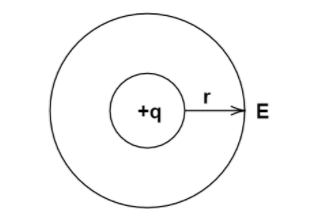
The number of electric field lines leaving the positive charge $0.5\;C$ placed in the medium of dielectric constant $K = 10$ are:
(A) $5.65 \times {10^9}$
(B) $1.13 \times {10^{11}}$
(C) $9 \times {10^9}$
(D) $8.85 \times {10^{ - 12}}$
Answer
218.4k+ views
Hint: We need to find the relation between the electric field due to a charge, the number of electric field lines, and the dielectric constant in the system of a charge. We can relate this by means of the formula for electric field strength from Coulomb’s law.
Complete step-by-step solution:
The number of electric field lines evolving from a charge is the electric flux of the system. It is defined as the number of electric field lines produced by a charge enclosed in a given area surrounded by the charge at a distance say $r$ from the charge.
We know that the electric field strength is given from the coulomb’s law as the force experienced per unit charge due to another charge at a distance $r$ . It is given as;
$E = \dfrac{1}{{4\pi {\varepsilon _0}}}\dfrac{q}{{{r^2}}}$
Now, we can find the number of field lines due to the charge $q$ in an area enclosed within $r$ units from the charge.

The electric flux is given as-
$A = 4\pi {r^2}$
Now, we can find the number of field lines or electric flux for a charge $0.5\;C$ placed in a dielectric medium with $K = 10$, is given as,
$E = \dfrac{1}{{4\pi \varepsilon }}\dfrac{q}{{{r^2}}}$
$ \Rightarrow E = \dfrac{k}{K}\dfrac{q}{{{r^2}}}$
where, $k = \dfrac{1}{{4\pi {\varepsilon _0}}}$ and $K = \dfrac{\varepsilon }{{{\varepsilon _0}}}$
Also, $A = 4\pi {r^2}$
Now,
$\phi = E.A$
$ \Rightarrow \phi = \dfrac{k}{K}\dfrac{q}{{{r^2}}}4\pi {r^2}$
Upon substituting the values we get,
$\phi = \dfrac{{9 \times {{10}^9} \times 0.5 \times 4\pi }}{{10}}$
$ \Rightarrow \phi = 5.65 \times {10^9}$
The electric flux or the number of field lines passing through the surface of the sphere at a distance $r$ from the charge is $\phi = 5.65 \times {10^9}$ .
The correct answer is option (A).
Note: The idea of electric flux density is more generally used than the number of field lines or the electric flux. It is the measure of the concentration of field lines at distance from the charge. For a parallel field, the electric flux is not dependent on the distance from the source.
Complete step-by-step solution:
The number of electric field lines evolving from a charge is the electric flux of the system. It is defined as the number of electric field lines produced by a charge enclosed in a given area surrounded by the charge at a distance say $r$ from the charge.
We know that the electric field strength is given from the coulomb’s law as the force experienced per unit charge due to another charge at a distance $r$ . It is given as;
$E = \dfrac{1}{{4\pi {\varepsilon _0}}}\dfrac{q}{{{r^2}}}$
Now, we can find the number of field lines due to the charge $q$ in an area enclosed within $r$ units from the charge.

The electric flux is given as-
$A = 4\pi {r^2}$
Now, we can find the number of field lines or electric flux for a charge $0.5\;C$ placed in a dielectric medium with $K = 10$, is given as,
$E = \dfrac{1}{{4\pi \varepsilon }}\dfrac{q}{{{r^2}}}$
$ \Rightarrow E = \dfrac{k}{K}\dfrac{q}{{{r^2}}}$
where, $k = \dfrac{1}{{4\pi {\varepsilon _0}}}$ and $K = \dfrac{\varepsilon }{{{\varepsilon _0}}}$
Also, $A = 4\pi {r^2}$
Now,
$\phi = E.A$
$ \Rightarrow \phi = \dfrac{k}{K}\dfrac{q}{{{r^2}}}4\pi {r^2}$
Upon substituting the values we get,
$\phi = \dfrac{{9 \times {{10}^9} \times 0.5 \times 4\pi }}{{10}}$
$ \Rightarrow \phi = 5.65 \times {10^9}$
The electric flux or the number of field lines passing through the surface of the sphere at a distance $r$ from the charge is $\phi = 5.65 \times {10^9}$ .
The correct answer is option (A).
Note: The idea of electric flux density is more generally used than the number of field lines or the electric flux. It is the measure of the concentration of field lines at distance from the charge. For a parallel field, the electric flux is not dependent on the distance from the source.
Recently Updated Pages
A square frame of side 10 cm and a long straight wire class 12 physics JEE_Main

The work done in slowly moving an electron of charge class 12 physics JEE_Main

Two identical charged spheres suspended from a common class 12 physics JEE_Main

According to Bohrs theory the timeaveraged magnetic class 12 physics JEE_Main

ill in the blanks Pure tungsten has A Low resistivity class 12 physics JEE_Main

The value of the resistor RS needed in the DC voltage class 12 physics JEE_Main

Trending doubts
JEE Main 2026: Application Form Open, Exam Dates, Syllabus, Eligibility & Question Papers

Derivation of Equation of Trajectory Explained for Students

Hybridisation in Chemistry – Concept, Types & Applications

Understanding the Angle of Deviation in a Prism

Understanding Collisions: Types and Examples for Students

Understanding Atomic Structure for Beginners

Other Pages
JEE Advanced Marks vs Ranks 2025: Understanding Category-wise Qualifying Marks and Previous Year Cut-offs

How to Convert a Galvanometer into an Ammeter or Voltmeter

Understanding Centrifugal Force in Physics

JEE Main Marking Scheme 2026- Paper-Wise Marks Distribution and Negative Marking Details

Degree of Dissociation: Meaning, Formula, Calculation & Uses

Understanding Electromagnetic Waves and Their Importance




